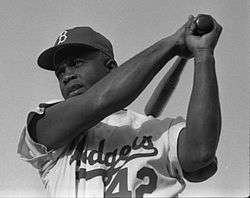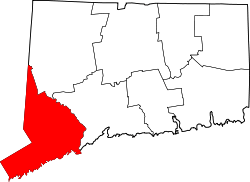North Stamford
| North Stamford | |
|---|---|
| Neighborhood | |
| Country |
|
| State |
|
| County | Fairfield |
| City | Stamford |
| Population | 14,904 |
| Time zone | UTC-5:00 (Eastern) |
| • Summer (DST) | UTC-4:00 (Eastern) |
| Area code(s) | 203 |
North Stamford is a section of Stamford, Connecticut, USA, north of the Merritt Parkway. Mostly woody and hilly, it is the least densely populated, and highest income section of the city. The two main roadways in North Stamford are High Ridge Road (Connecticut Route 137) and Long Ridge Road (Connecticut Route 104). North Stamford borders Pound Ridge, New York at the New York line to the north, the "back country" section of Greenwich, Connecticut to the west, and the Town of New Canaan, Connecticut to the east. According to the 2010 census, North Stamford has a population of 14,904. The City of Stamford as a whole had a population of 122,643 (per the 2010 Census) with most recent estimates showing Stamford's population around 128,000.
High Ridge Road, in the area just south of the Merrit Parkway, is the largest shopping district near North Stamford. A shopping plaza and some surrounding stores are also nearby on Newfield Avenue, and downtown Springdale also offers nearby stores.
When Stamford's population began to grow during and after World War II, 30,000 new residents arrived from 1940 to 1960. "North Stamford developed with one- and two-acre zoning, looking just like Wilton or New Canaan," Janice Green, the manager of the William Pitt Real Estate office, told The New York Times in 1989. "Executives moved up there who had no connection with the factories and ethnic working-class neighborhoods downtown."[1]
Landmarks and institutions
Water reservoirs which provide water service to the City of Stamford are located in North Stamford, as are the Bartlett Arboretum and the Stamford Historical Society headquarters and museum.
Also in the neighborhood is the Stamford Museum and Nature Center, a 118-acre (0.48 km2) facility on Scofieldtown Road. The museum works with schools in Stamford, Bridgeport, Norwalk, Darien and Greenwich, and more than 10,000 students visit every year. In 2007 the museum and nature center started working with Aquarion, a water utility serving much of Fairfield County, in a program meant to educate children about water ecology and watershed protection.[2]
Buttonwood Manor, a Colonial-style house on an estate of 8 acres (32,000 m2), is in North Stamford. The original main house was built by Jacob Stevens in 1809, then sold it in 1821 to Gould Raymond. For 77 years the Raymond family farmed the land. By 1926 Mary Stella Tisdale Atwood had bought the house from Otto Sarrach and began restoring it. She sold the estate to William E. Stevenson, a Gold Medal winner in the 1924 Summer Olympics in Paris (setting a new world record of 3:16.0 as member of the American 400-meter relay team) and later a president of Oberlin College. While Stevenson and his wife were in England running American Red Cross operations in World War II, they rented the house to Dorothy Fields, a lyricist.[3]
Parks
1. Chestnut Hill Park-Chestnut Hill Rd & Webbs Road
2. Dorothy Heroy Park-Riding Stable Trail
3.Scofieldtown Park-Scofield Town Road.
4.Woodley Road Bird Sanctuary-Off Scofield Town Road
5. Mianus River Park-Merribrook Lane
6.Newman Mills Park-Riverbank Road
Emergency Services
Fire service in North Stamford is provided by a combination of volunteer and professional firefighters. Stamford Fire Rescue Department's Fire Station #'s 8 and 9 serve the neighborhood, as well as the Turn of River Volunteer Fire Department Station #'s 1 and 2 and the Long Ridge Volunteer Fire Department's Station #'s 1 and 2.
North Stamford is patrolled by police officers from the City of Stamford Police Department (SPD).
Emergency Medical Service coverage in North Stamford is provided by Stamford EMS units. Stamford EMS has paramedics respond to all of their calls for service.
Secession Movement of 1990s
The New York Times reported in 1995 that in the 1990s many North Stamford residents were seriously considering a secession movement to form a town separate from the City of Stamford.[4] Many North Stamford residents calculated that creating their own town would significantly reduce property taxes. The Concerned Citizens of North Stamford argued that North Stamford residents pay nearly a third of Stamford's property taxes although they make up less than 15 percent of the city's population and in return receive less city services. North Stamford residents do not receive city garbage collection (as does most of the rest of the city), must provide their own water and sewerage systems, have less police protection and, largely, have their children bused to schools in other parts of town. The New York Times reported that in 1995, that Stamford's then Mayor Esposito strongly opposed the movement. Mayor Esposito cited a plan by the city to permit the conversion of the vacant Riverbank School into a 53-bed residential hospice along with offices for Hospice Care Inc as a strong reason against the movement. Although the Concerned Citizens of North Stamford received about 600 signatures in a petition for the secession movement, it ultimately failed because many North Stamford residents were opposed to the plan and were discouraged by the complex process of secession in the State of Connecticut. Secession would require a revision of the City charter and the approval of the State Legislature. It is unlikely the City of Stamford would allow the lucrative revenue stream of property taxes from North Stamford to cease and for State legislators to approve a major municipality separation without the City of Stamford's support. There is very little to no legitimate discussions on secession in our current day as North Stamford is seen as an established part of the City of Stamford legally and functionally. Secession movements also took place in 1990s in the Rowayton section of Norwalk, Connecticut and the East Shore section of New Haven, Connecticut with those residents citing similar concerns. All of these movements were unsuccessful and their neighborhoods remain within their larger cities jurisdiction.
Historical Cemeteries
North Stamford contains numerous old cemeteries from the nineteenth century and before, some quite small and often with gravestones bearing elaborate engravings and even poetry.[5]
These old cemeteries are in North Stamford:[5]
- June (1846-1866) — north side of Constance Road, in the woods
- William S. June, 1846, age 25:
- Dear young friends, as you pass by
- As you are now so once was I
- As I am now so you must be
- Prepare for death & follow me
- William S. June, 1846, age 25:
- Webbs Hill (1796-1878) — east of Webbs Hill Road, south of Jeffrey Lane
- Dean (1838-1891) — south side of Lolly Lane
- Seth Smith (1831-1846) — southeast corner of Riverbank Road and Riverbank Drive
- Ebenezer Smith (1835-1877) — west side of Riverbank Road
- Isaac Smith (1860) — west side of Riverbank Road
- Scofieldtown (1807-1932) — east side of Scofieldtown Road, north of Woodley Road
- Thaddeus Lockwood (1827-1851) — east side of Riverbank Road
- Hait (1807-1860) — west side of Riverbank Road, south of Farms Road
- Edwin R,. Lockwood (1857-1896) — east side of Hunting Ridge Road
- North Stamford (1776-1932) — east side of Lakeside Drive, north of reservoir
- Poorhouse (no dates) — east side of Scofieldtown Road, southeast of former University of Connecticut campus
- East Hunting Ridge (1830-1856) — northeast corner of East Hunting Ridge and Haviland roads
- Smith-Clason (1826-1849) — south side of Hunting Glen Road
- Brush (1760-1828) — west side of East Middle Patent Road
- Long Ridge Union (1796-"present" [at least 1980]) — south side of Erskine Road near Long Ridge Road
- High Ridge (1796-"present" [at least 1980]) — west side of High Ridge Road, opposite United Methodist Church
|
|
Notable North Stamford residents, past and present

- Henri Willis Bendel had an estate in North Stamford, see Stamford Museum and Nature Center.
- Michael Bolton, singer, lived in North Stamford (as of 1998) before moving to Westport.[6]
- Gutzon Borglum, sculptor of Mount Rushmore, lived in North Stamford[6] from 1910 to 1920.
- Chambers Brothers, psychedelic soul, recorded Time Has Come Today. with drummer Brian Keenan, were the second black family to integrate North Stamford
- Dorothy Fields, lyricist, rented Buttonwood Manor from William E. Stevens during World War II.[3]
- Benny Goodman, jazz and swing musician lived in North Stamford.[6]
- Harry Houdini, magician and escape artist, had a home on Webbs Hill Road.
- Cyndi Lauper, singer, has (or had, as of 1998) a home in North Stamford.[6]
- Josh Logan, a theatrical producer, lives or lived (as of 1998) in North Stamford.[6]
- Ezio Pinza, a star of the Metropolitan Opera, was a resident of North Stamford.[6]
- Alex Raymond, creator of the Flash Gordon comic strip, lived in North Stamford.[6]
- Jackie Robinson, the first African-American baseball player in the modern Major Leagues, made North Stamford[6] his home later in his life. One of the several Stamford Little League Baseball leagues is named after him.
- Chuck Scarborough, news presenter for WNBC-TV Channel 4 in New York City, has a home here.
- Stephen Sondheim lived in North Stamford when he was a boy.[7]
- William E. Stevenson, 1924 Olympic Gold Medal winner in track, president of Oberlin College, bought Buttonwood Manor in 1937.[3]
- Bobby Valentine, former manager of the New York Mets and Boston Red Sox, has a home in North Stamford.
- Gene Wilder, actor, was a resident before passing away in August 2016.
- Travis the Chimp lived in North Stamford before being shot and killed by police after going on a rampage and assaulting a friend of his owner.
- Carly Simon's parents owned the estate which is now a private school campus on Newfield Avenue.
- Gutzon Borglum owned a sizable estate north of what is now the Merritt Parkway near High Ridge Road.
- Michael Lee Aday aka rockstar Meat Loaf lived on Eagle Drive in the late 1970s and early 1980s. He coached local little league baseball during that period.
- Vivian Vance, actress was a resident from 1961 to 1974.
- Gilda Radner, comedian, actress.
Notes
- ↑ Charles, Eleanor, "If You're Thinking of Living in: Stamford", The New York Times, August 20, 1989
- ↑ Gosier, Chris, "Environmental immersion: Water company and nature center form watershed education alliance", The Advocate, pp A9, A10, Stamford edition
- 1 2 3 Nova, Susan, "Manor is rich with history: Offer has been accepted to buy 5,300-square-foot (490 m2) home", The Advocate Real Estate section, April 20, 2007, pp. R1, R4
- ↑ Cavanaugh,Jack "Another Day, Another Secession Movement","Another Day, Another Secession Movement", The New York Times, February 26, 1995
- 1 2 Majdalayny, Jeanne and Mulkerin, Jean, Poems in Stone in Stamford, Connecticut, published by the Stamford Historical Society, 1980
- 1 2 3 4 5 6 7 8 "If You're Thinking of Living In/North Stamford, Conn.; In a Bustling City, a Rural Haven" an article by Eleanor Charles in New York Times Real Estate section, February 1, 1998, accessed September 10, 2006
- ↑ "From the Archives" feature in The Advocate of Stamford, Connecticut, July 23, 2007, "25 years ago", "July 25, 1982" item; page A7
